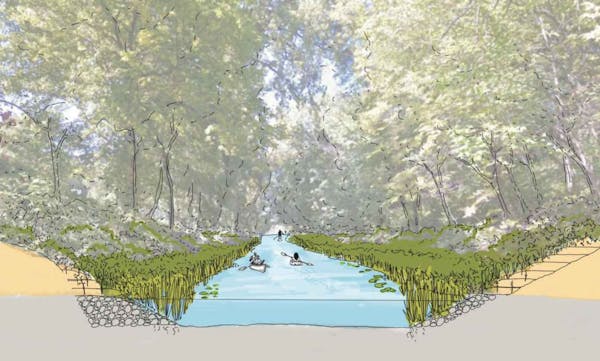Scores of tourists in jackets and hoodies posed for pictures Monday at the headwaters of the Mississippi River in Itasca State Park before walking across the rock dam marking the end of Lake Itasca and the start of the continent's second longest river.
But the walk across the fledgling Mississippi is longer than it used to be. With 500,000 visitors a year dragging sand, dirt and gravel into the stream, the heavy foot traffic combined with water flow scouring the shoreline has considerably widened the channel.
So the Minnesota Department of Natural Resources plans to narrow the channel and shrink it close to its original width as part of a $35,000 restoration project set to begin in October and partly funded with money from the state Parks and Trails Fund, created after passage of the Clean Water, Land and Legacy Amendment in 2008.
Simply put, the headwaters have been slowly eroding away, said Itasca State Park manager Aaron Wunrow.
"This project will use a natural design approach to ensure it remains protected into the future, maintaining the existing high water quality and healthy stream system," Wunrow said.
The headwaters will be closed for five days sometime between Oct. 5 and 16 as the DNR carries out the work, according to a department advisory.
Plans call for workers to place additional boulders on the shoreline, including flat boulders that will provide safer access to the river. Vegetation that can quickly establish roots along the riverbank will be added to provide erosion protection.
The headwaters' appearance will not change dramatically, but the project will re-establish the natural width of the river at that point, Wunrow said.
Photos from the 1920s show that the river was so narrow at the headwaters that people on opposite sides could almost grab hands. It grew slightly wider in the following years, before the Civilian Conservation Corps hauled in tons of fill in the 1930s to create a channel and built a dam of rocks.
The dam, however, is now failing to keep water away from the shoreline, leading to major erosion of the riverbank.
Adding more rock to the top of the dam and along the shore will help reshape the channel and stabilize the banks by directing water flow toward the middle of the stream.
The erosion appears to be limited to the headwaters, Wunrow said.
"The river downstream of the headwaters is still intact and shows no visible impacts from the erosion," he said.

Fall or spring, it's Rochester Mayo's year in prep tennis

Minneapolis reaches $150k settlement with eyewitness of George Floyd's murder

Israel-Hamas war creates 'really fraught times' at Minn. colleges

Rare and fatal brain disease in two deer hunters heightens concerns about CWD

